 THE LOW-DOWN ABOUT NUCLEAR FUSION AND HELIUM-3
THE LOW-DOWN ABOUT NUCLEAR FUSION AND HELIUM-3
By Erich Habich-Traut, based on University of Wisconsin-Madison files and others
The perception in the public mind is that nuclear fusion will be the solution to humanity's energy needs in the future: limitless, cheap and without ANY risk.
The technology is still in its infancy, and previous estimates of having a commercially viable working fusion prototype reactor have ranged from 10 to 30 years in the future.
The Massachusetts Institute of Technology (MIT) is currently working on a prototype using deuterium and tritium as fuel, named the ARC, which they hope to have up and running in 10 years time.
Before exploring the ARC concept, we'll take a closer look at a report about the Helium 3 alternative. Because not all fusion is the same, not all systems are equally safe and cost efficient. It depends on the fuel.
Based on estimates of the world's growing need for energy, it is unavoidable to consider fusion energy, which is a type of nuclear energy.
Fusion reactors can take different types of fuel. In the public perception it is water which fuels any fusion reactor. But that is not exactly true.
There are four different fuel combinations (Fusion Fuel Cycles) that have been proposed to make a fusion reactor work:
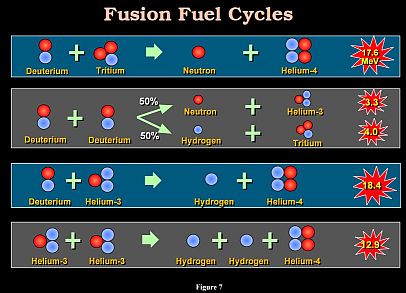 1. Deuterium (heavy hydrogen) & Tritium (radioactive isotope of hydrogen)
1. Deuterium (heavy hydrogen) & Tritium (radioactive isotope of hydrogen)
This combination is the easiest form of fusion to accomplish. The MIT ARC reactor will work with this fuel. It has a high energy yield.
2. Deuterium & Deuterium
Doesn't have a high energy yield
3. Deuterium & Helium-3
This has the highest possible energy yield of all fuels.
4. Helium-3 & Helium-3
Medium energy yield, the only reaction that does not produce radioactive byproducts (neutrons), hence, the safest method.
The reason that research into the deuterium tritium (DT) fusion reactors is the most advanced and close to completion (10 years), is that Helium-3 is in short supply and the fusion reaction is the 'easiest' to accomplish.
We need to remember that Helium-3 is a byproduct of the fusion cycle going on in the sun. On Earth it is too difficult to obtain He-3. But the solar wind has been depositing this non-radioactive isotope in relative abundance on the surface of the Moon.
Looking at risk versus the cost factor of fusion reactors.
What? Risk from nuclear fusion? How can that be?
 THE DEUTERIUM-TRITIUM FUSION REACTOR (Tokamak)
THE DEUTERIUM-TRITIUM FUSION REACTOR (Tokamak)
Admittedly, the risk from a DT fusion reactor is quite small.
In the worst case scenario no fatalities are expected outside of the reactor building.
The worst amount of radioactivity that a DT Tokamak fusion reactor could spread is the same as in a normal nuclear fission reactor. And after a hundred years the contamination will only be 0,1 percent of the radioactive wasteland that a conventional fission reactor leaves behind (Fukushima, et all).
This is because different radioactive isotopes are in play.
Such a reactor, once it is built, will need new walls every 3-4 years (expensive).
The cost of Tokamak fusion is projected to be 1.5 times higher than a fission reactor.
ALL fusion reactor designs currently under development are built on this design.
------------------------
ANY HELIUM-3 FUSION REACTOR
As soon as He-3 is introduced as fuel into the fusion reactor equation, the risk factor, building cost and service life changes greatly for the better.
Only 3% of radioactive materials versus fission are produced in Deuterium - Helium-3 reactions. Reactor wall replacements are no longer an issue, because they last for the full lifetime of the structure without having to replace them at short intervals. In the worst case scenario (catastrophic failure), no evacuation is needed and no fatalities are expected.
THE PURE HELIUM-3 REACTOR
This design is the safest. The pure He-3 reaction produces zero radioactivity, no fatalities even in the worst case, whilst having a yield that is two times higher in comparison to fission. Building this type of fusion reactor is also expected to be the cheapest option of them all, cheaper than fission. And we all know of the Billions of tax Dollars that has gone into the development, construction and building of conventional fission reactors. Not to mention the clean-up operations afterwards.
THE DEUTERIUM - TRITIUM TOKAMAK FUSION REACTORS
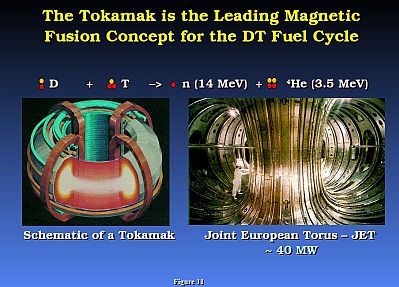
So, is nuclear fusion the answer to humanities energy needs?
When Deuterium and Tritium are fused in a Tokamak, very very high temperatures are the result. We are talking 150 Million degrees Celsius. In order to contain the hot plasma it is trapped in a doughnut shaped ring, made of high-powered magnets. This is shown in the picture on the left.
The size of these Tokamak fusion reactors is described as "small".
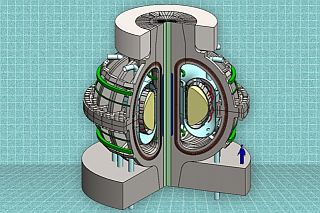 The ARC Tokamak reactor has a major radius of 3.3 m.
The ARC Tokamak reactor has a major radius of 3.3 m.
In the illustration on the left a human figure has been added, to get an idea on the scale. Another fusion reactor, the ITER, has a diameter of 6.2 meters, meaning it is twice the size.
The cumulative cost of building the ITER reactor has been 14 Billion Dollars up to the year 2015. The projections are that once mass production of this type of reactor starts, the prize will fall below 10 Billion Dollars each.
CONSTRUCTION AND SIZE ADVANTAGES OF HELIUM-3 REACTORS

Although Deuterium-Helium-3 fusion has been accomplished in Tokamak reactors (JET), a simpler, more compact, design is better suited.
Such an (experimental) device is shown on the left, a DARPA research project.
This type of reactor contains the hot plasma in magnetic confinement but the design is radically different.
Less materials means lower costs, in this case. The magnetostatic confinement of the fusion reaction with Helium-3 takes place in a box-like enclosure with magnetic coils. Whilst I can't compare the building plans and power output directly, it can be seen that the size of a Helium-3 reactor appears significantly smaller.
This type of device is said to be much more effective than a Tokamak for Deuterium-Helium-3 fuels and it is the only known way to make ³He-³He reactions work.
FURTHER APPLICATIONS OF THE HELIUM-3 FUSION REACTION
Fusion rockets are better than conventional rockets in a several ways:
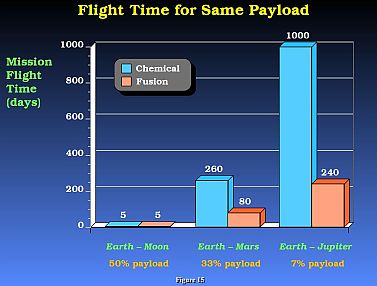 1. They can maintain full thrust for over 11 days nonstop ( 14 Mev protons)
1. They can maintain full thrust for over 11 days nonstop ( 14 Mev protons)
(Depending on the design)
2. The thrust from the same engine is variable for full power, or high speed
3. Long distance travel times are drastically reduced
Based on the paper I am referring to, from the Wisconsin Center for Space Automation, it would be more than 3 times faster to reach Mars with a Helium-3 fusion rocket than with a chemical rocket. The further the distance to be covered the more pronounced becomes the time saving, making this type of propulsion a good option for interplanetary missions.
ARE THERE ACTUAL DESIGNS FOR HELIUM-3 FUSION ROCKETS?
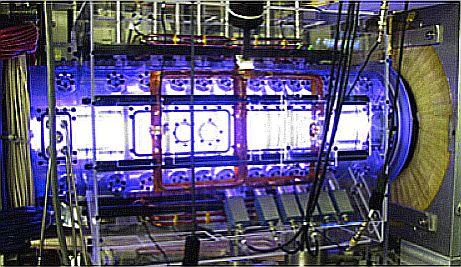 Fusion-powered rockets that are only the size of a few refrigerators could soon help propel spacecraft at high speeds to nearby planets or even other stars, a NASA-funded spaceflight company says.
Fusion-powered rockets that are only the size of a few refrigerators could soon help propel spacecraft at high speeds to nearby planets or even other stars, a NASA-funded spaceflight company says.
This small outfit, Princeton Satellite Systems, claims that whereas modern fusion experiments might cost $20 billion, a prototype fusion rocket the researchers plan to develop should cost just $20 million. So far, they have received three NASA grants to fund the project.
"It would probably be 1.5 meters [4.9 feet] in diameter and 4 to 8 meters [13 to 26 feet] long," Michael Paluszek , President of Princeton Satellite Systems, said.
About 10 years ago, reactor designer Sam Cohen figured out a magnetic-field design "that could make stable plasmas," Paluszek explained. Cohen is the inventor of the Princeton Field Reversed Configuration reactor that is the core of the PSS engine.
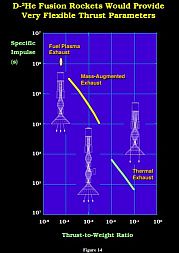 The researchers have not yet demonstrated fusion with their device, but aim to do so by 2019 to 2020. They intend to do so with Deuterium-Helium-3 fuel.
The researchers have not yet demonstrated fusion with their device, but aim to do so by 2019 to 2020. They intend to do so with Deuterium-Helium-3 fuel.
No outfit has yet investigated the feasibility of a ³He-³He rocket design,
to my knowledge. The advantage would be that no neutrons would be produced as a byproduct of the fusion reaction, and no additional shielding would be required.
WHERE TO FIND HELIUM-3?
That is the problem. On Earth there are only few sources. Other than that, small amounts are produced as a byproduct of radioactive decay in fission reactors. In space Helium-3 could be scooped from the atmospheres of Jupiter or Saturn.
And then, there is the Moon.
Whilst a number of national space agencies are still arguing about the benefit of mining Helium-3 from the Moon, China appears to be actively pursuing this goal. The first step would be the establishment of a permanent Moon base and operations.
The logical extension of this train of thought is that a company whose declared goal is the colonization of Mars should be looking into this.
CORPORATE SECRETS?
'Elon Musk Calls for Moon Base', July 19, 2017. Why?
Elon Musk wants to colonize Mars. If he wants access to a more efficient fuel for this goal, a Moon base is the logical step, for He-3 mining. https://www.space.com/37549-elon-musk-moon-base-mars.html
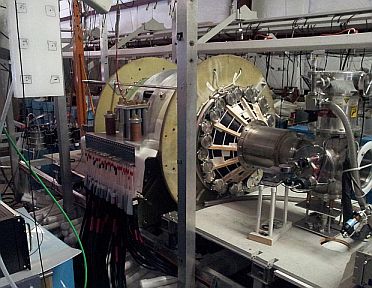 "The next platform in the evolution of our human economy, the control of atomic processes like those found in our Sun, will be applicable not only to energy production and materials creation here on Earth: the development of this power will be the means to conquer the entire domain of our Sun’s influence, the Solar System, and will ultimately put us in range of our closest neighbouring stars."
"The next platform in the evolution of our human economy, the control of atomic processes like those found in our Sun, will be applicable not only to energy production and materials creation here on Earth: the development of this power will be the means to conquer the entire domain of our Sun’s influence, the Solar System, and will ultimately put us in range of our closest neighbouring stars."
Jeremy Beck
(Ref. 0)
In conclusion, the development of fusion reactors without an element of HE-3 is the easiest option.
It is not the cheapest or smallest version of achieving nuclear fusion, nor the safest. China's ambitious goal of HE-3 mining on the moon can help solve it's clean energy needs. Using the secondhand power of solar fusion from the Sun in solar panels is not as efficient as fusion, in terms of size of the power plant. HE-3 fusion is a way to use the pre-processed non-radioactive by-products of solar fusion, in a concentrated fuel, which solves the energy storage problem, because HE-3 is the energy store.
HE-3 is a sustainable fuel, because it is being generated continously by the Sun.
I've attached Powerpoint slides and images that clarify the points made in this presentation,
as well as links that go deeper into the subject matter.
------------------------------
REFERENCES:
Ref. 0: China’s Helium-3 Program: A Global Game-Changer
(The Moon—“Persian Gulf” of the Solar System)
http://www.spacesafetymagazine.com/space-on-earth/everyday-life/china-helium-3-program/
Ref. 1: Helium-3 Fusion Reactors, A Clean and Safe Source of Energy in the 21st Century, by Gerald L. Kulcinski, Wisconsin Center for Space Automation and Robotics, http://fti.neep.wisc.edu/pdf/wcsar9304-1.pdf
Ref. 2: A small, modular, efficient fusion plant
http://news.mit.edu/2015/small-modular-efficient-fusion-plant-0810
Ref. 3: MIT takes a page from Tony Stark, edges closer to an ARC fusion reactor (+video)
http://www.computerworld.com/article/3028113/sustainable-it/mit-takes-a-page-from-tony-stark-edges-closer-to-an-arc-fusion-reactor.html
Ref. 4: ARC: A compact, high-field, fusion nuclear science facility and demonstration power plant with demountable magnets
http://www.sciencedirect.com/science/article/pii/S0920379615302337
Ref. 5: Cost estimate of building Tokamak DT fusion reactors:
https://www.euro-fusion.org/faq/new-how-much-will-constructing-a-plant-that-creates-fusion-power-cost/
Ref. 6: Rocket powered by nuclear fusion could send humans to Mars
http://www.washington.edu/news/2013/04/04/rocket-powered-by-nuclear-fusion-could-send-humans-to-mars/
Ref. 7: Could Tiny Fusion Rockets Revolutionize Spaceflight?
https://www.scientificamerican.com/article/could-tiny-fusion-rockets-revolutionize-spaceflight/
Ref. 8: Princeton Satellite Systems
http://www.psatellite.com/fusion/
Ref. 9: Quick Fusion-Powered Trips to Mars No Fantasy, Scientists Say
(Deuterium-Tritium cycle)
https://www.space.com/23084-mars-exploration-nuclear-fusion-rocket.html
Ref. 10: China is going to mine the Moon for helium-3 fusion fuel
https://www.extremetech.com/extreme/197784-china-is-going-to-mine-the-moon-for-helium-3-fusion-fuel
Ref. 11: What is Helium-3?
https://en.wikipedia.org/wiki/Helium-3
Ref. 12: Proton Collimators for Fusion Reactors
http://www.techbriefs.com/component/content/article/ntb/tech-briefs/physical-sciences/1394
 1. Deuterium (heavy hydrogen) & Tritium (radioactive isotope of hydrogen)
1. Deuterium (heavy hydrogen) & Tritium (radioactive isotope of hydrogen)







